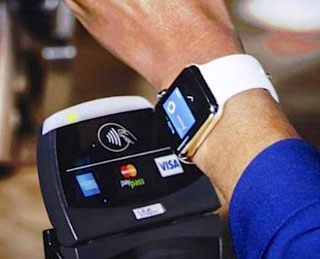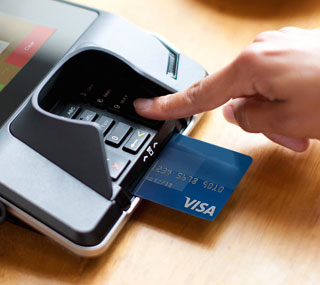
Vol. XV, No. 4, May 2015
- Editor's corner
- Foundations Entertainment University 2.0 adds 12 new topics for July 14-16 Chicago seminar program
- My FEC is feasible since there's nothing in my town for families to do
- Moo Town, USA opens
- The trade show everyone should attend, but few do
- Trends with age of marriage, 1st births, childlessness & family size
- Dairy or no dairy: The various degrees of vegetarianism
- Harnessing the power of FoMO
- Chasing the next BIG Thing
- The next generation of credit card payment technology
- Trends found at the restaurant show
- Latest scoop on alcoholic drinks
The next generation of credit card payment technology
If we asked you if your facility accepted credit cards, you would almost certainly say yes. But that may not be exactly true. Sure, you can probably swipe your old fashioned Visa or MasterCard but can we wave my Google Wallet-enabled Android or Apple Pay-enabled iPhone by your terminal or insert a Chipped card in your EMV enabled terminal? How secure is your system from fraudulent purchases and if a fraudulent purchase occurs are you liable? Don't have all the answers to the questions? Not quite sure what some of this even means? Don't worry; we will break it down for you.
Let's start with NFC or near field communication. NFC is exactly what it sounds like, a technology that allows two devices to communicate when they are near each other. It is the technology that allows credit card terminals to talk to phones, contactless cards, even your Apple Watch in order to receive payment.

Here's how it works. Using an application on your phone such as Apple Pay, the phone or watch is waved near the credit card terminal and a connection is made using NFC. The phone takes the credit card information you gave it and sends it securely to the terminal and the payment is processed. You may have to scan your finger or enter a PIN as an additional layer of security. It's an elegant solution providing a secure method of payment in an easy to use package.
Up until recently, there has been a slow acceptance of NFC since both the purchaser and the retailer must possess an NFC compatible device, a NFC capable smartphone for the purchaser and an NFC capable terminal for the retailer. No matter how many tech-savvy shoppers jump on the NFC bandwagon, there is really no point if there are no retailers where they can use it. And since NFC capable terminals cost money and standard terminals are servicing the retailers just fine, there has been no reason for them to embrace NFC technology. But that is going to change. And the reason is another new technology, the IC or “Chip Card.”

The chip card, like its name suggests, uses a secure microchip instead of the easy-to-copy magnetic strip to provide its customers with increased security. The system for processing these cards, called EMV has been in use for over a decade in Europe and this system and the chip card itself are now becoming the standard for secure spending in the U.S. While we all want greater security and fraud prevention on our cards many retailers are understandably reluctant to shell out the expense for the new processing equipment required to accept these cards.
So why worry about accepting chip cards? After all, right now the majority of cards in the U.S. don't have chips and even if they become more popular they still have a magnetic strip as a backup option (at least for now). Why not just ignore the whole chip card issue altogether?
The answer lies in a deadline that you may be completely unaware of: a shift in fraud liability by all the major credit card companies as of October 2015. Right now if a customer came into your facility with a stolen card and purchased something you would not be liable if they use a counterfeit card. The card-issuing bank is liable. That will change this October. If you are using a credit card terminal that is not EMV (chip card) compliant and a counterfeit card is used, the liability of the charges will shift from the bank to you. This liability shift is essentially forcing the retail industry to upgrade to the EMV compliant terminals if they want to avoid increased fraud liability.
So what is the upside of this necessary upgrade? It is the perfect time to upgrade to NFC as well. 80% of VeriFone's 2014 3rd quarter EMV terminal sales included the near field technology. According to VeriFone CEO Paul Galant “…the migration to EMV will certainly significantly increase…the potential for the use of NFC in payment and commerce”. And companies such as Apple, which as introduced an NFC compatible iPhone and Apple Watch, are apparently expecting an increase in NFC availability as well. In fact if the fraud liability changes aren't enough to convince you to update your system, consider this. As NFC become more common due to these changes, your clients will come to expect the technology everywhere they go. What will you tell your customers who arrive at your facility wanting to give you their money but can only pay with the iPhone?
Transitioning to the chip card and NFC technology could take some time. You will have to upgrade your terminal and possibly your POS system as well as re-train your employees. Now is the time to start looking at your options in order to make a smooth transition prior to the October deadline.
Vol. XV, No. 4, May 2015
- Editor's corner
- Foundations Entertainment University 2.0 adds 12 new topics for July 14-16 Chicago seminar program
- My FEC is feasible since there's nothing in my town for families to do
- Moo Town, USA opens
- The trade show everyone should attend, but few do
- Trends with age of marriage, 1st births, childlessness & family size
- Dairy or no dairy: The various degrees of vegetarianism
- Harnessing the power of FoMO
- Chasing the next BIG Thing
- The next generation of credit card payment technology
- Trends found at the restaurant show
- Latest scoop on alcoholic drinks


